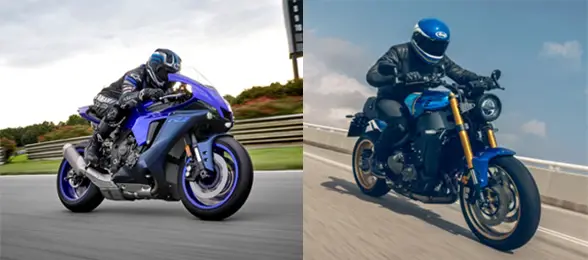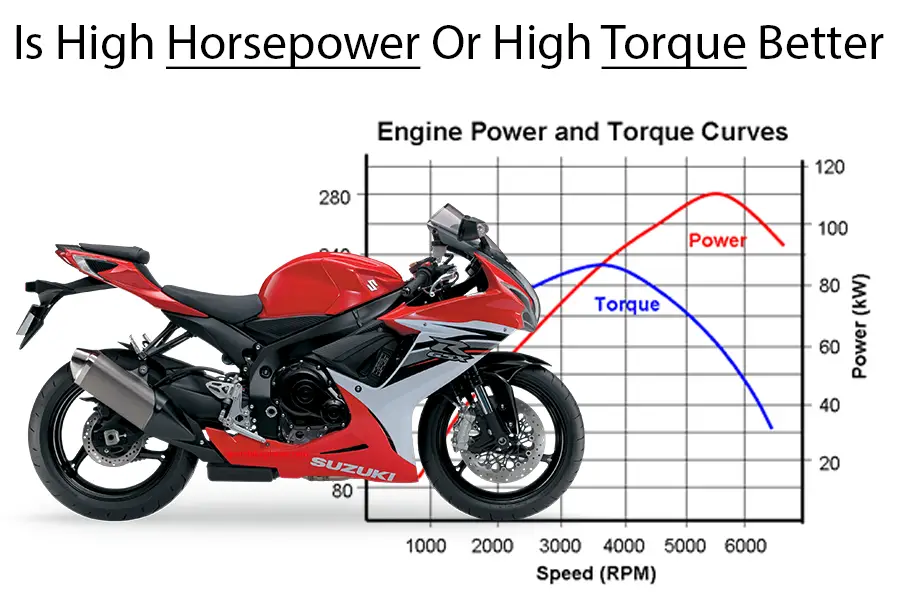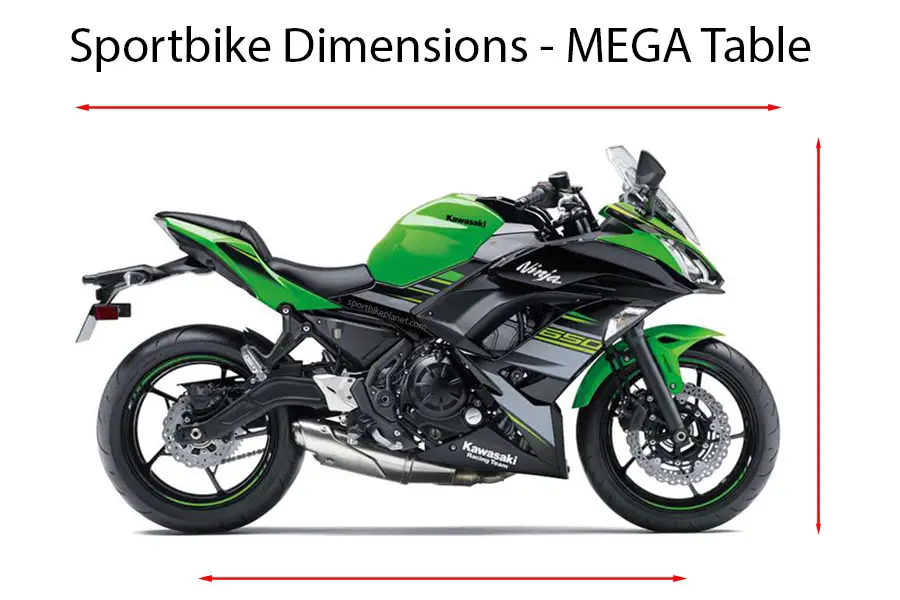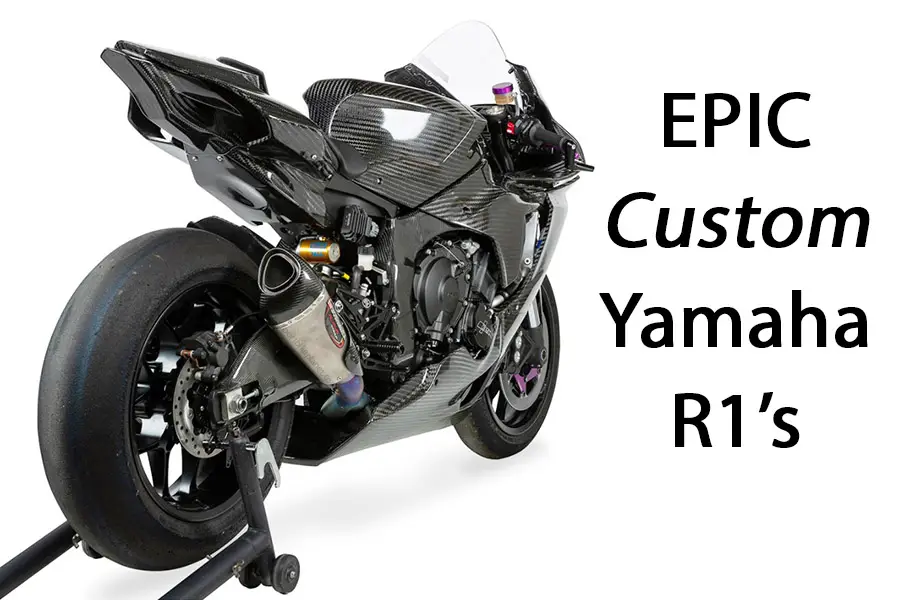An oft debated topic amidst motorcyclists and gearheads in general is this: Which is most beneficial to performance, horsepower or torque?
If high top speed is the priority high horsepower should be goal. However if maximum possible acceleration is more important to you then high torque should be the target. It’s the horsepower that dictates where your speedo maxes out, but it’s the torque that dictates how quickly you get to that point.
Let’s see why that is and how it impacts your riding, as well as going into a little more detail on why you might prefer high horsepower or high torque on your motorcycle…

Yamaha’s R1 goes faster, but the company’s XSR900 rides better long wheelies. Why, you ask? Read on. Source: yamahamotorsports.com
Motorcycle Horsepower Vs Torque In The Real World
When riding a peaky motorcycle, one with a horsepower/torque curve engineered for top speed, snapping the throttle open at moderate RPM produces minimal acceleration. What’s needed is a quick downshift or two, putting the engine in a higher revolution operating range, and now significant acceleration occurs.
When riding two somewhat comparable sportbikes, say Honda’s fabled V-Twin RC51 and a CBR1000 of similar vintage, the greater torque of the V-Twin engine configuration provides ample acceleration (and wheelies!) at far lower revolutions per minute.
Meanwhile, a quick downshift or two puts the inline four-cylinder CBR into its optimum operating range and this evens the score, and the CBR might pull away from its stablemate.
This is the result of similar goals achieved through dissimilar approaches.
The primary goal of torque is to make a motorcycle accelerate. More torque usually results in faster 0-60 mile per hour times, or 0-100 mph times.
Also, the heavier the vehicle, the more torque is required to achieve rapid acceleration.
With most performance motorcycles, i.e. sportbikes, the balance between horsepower and torque is largely balanced to offer the best of both worlds as much as it’s practical to do so.
Sportbikes make a lot of horsepower per liter, thus, they also put out higher torque numbers.
Still, discrepancies certainly exist, especially in the engine configuration you have on your motorcycle…
Is My Motorcycle Engine Better For Horsepower Or Torque
The number of cylinders, engine displacement and size, and the bore and stroke of your piston chambers, will typically dictate a large part of whether your motorcycle is more torquey or more horsepower heavy.
Engines are generally either “oversquare” or “undersquare.”

Displacement, which is the size of the space taken up by a piston in the engine, is bore (width) multiplied by stroke (length), and the ratio of these measurements is what determines whether your motorcycle engine is considered oversquare or undersquare.
Engines in which the bore (i.e. piston diameter) is larger than the stroke (the length the piston travels up and down within the cylinder) tend to produce more horsepower through higher revolutions per minute.
Perhaps counter intuitively, the shorter stroke actually means the piston is moving at a lower rate of speed even as the engine spins faster.
Conversely, undersquare motors where the piston travels a greater distance, and at a greater piston speed than its oversquare counterpart, tend to sacrifice a few ponies in favor of higher torque.
This is, however, an oversimplification of bore and stroke and the effect these dimensions have on power output.
Trucks, tractors, busses, and Harley Davidson motorcycles tend to lean towards torque output, as lifting (or accelerating) a heavy object requires more work.
With any two engines of roughly the same horsepower output, the one with more torque will feature a more rapid rate of acceleration but at the expense of top speed. The inverse is also true.
This is addressed by design engineers with transmission ratios. A gearbox allows the conversion of torque into top speed.
In short, and in another oversimplification, those looking for high speeds want horsepower and those wishing for acceleration crave torque.
What a motorcyclist wants is healthy balance between both.
What’s Better, High Motorcycle Power Or Torque
What a street motorcycle rider can use every time they throw a leg over the saddle is torque. Going from 0-65 with spirit, leaving a stoplight when it turns green, exiting an on-ramp onto the freeway… this is where torque comes in. On public roads, roll-on power and acceleration is where it’s at.
Horsepower figures can be a huge drawcard when marketing motorcycles. Quoting 200-plus horsepower for their superbike as every manufacturer now does is advertising nirvana. It sells motorcycles.
But in the real world, out on the streets as it were, torque is the more useful commodity.
Horsepower wins races, yes. Horsepower is for the track, where you can really let a big dog eat.
Although some of you do risk life and license by running triple-digit speeds on public roads, it’d ill advised.
Unless you have access to Germany’s Autobahn or are fortunate enough to reside on the Isle of Man, there’s nowhere legal to access a modern superbike’s, or even a middleweight bike’s, top speeds.
Legality aside, in any environment where not everyone is traveling the same direction, that kind of velocity creates braking distances that result in totaled machines… and humans… (Okay, lecture over.)
Getting Higher Motorcycle Horsepower Or Torque
Above I stated that the oversquare versus undersquare facet of engine design and its effect on power output was a bit of an oversimplification.
That’s because valve timing is really the main thing and should be considered if you really like getting into the nuts and bolts of how your current or future motorcycle performs.
To make the immense horsepower of modern day superbikes and middleweights, the engine’s cam profiles, valve sizes, and the amount of overlap are designed to fill the cylinders with fuel and air at optimum during higher rpm.
Intake valves open early. The closure is delayed to allow the rising piston to pump air out of the combustion chamber, thus making room for more fuel mixture. That’s longer valve timing in action.
Big cruisers and touring bikes require a lot of torque at low rpm, and thus use quite short valve timing.
The valves open and close in conjunction to make sure the engine always has a combustion mixture on tap.
Now, these shorter valve timings conversely run out of breath at higher rpm. They keep the engine full of fuel/air… but that means there isn’t as much room for more to enter.
To create big horsepower numbers, long valve overlap is required. This reduces torque at lower and mid rpm.
Often, manufacturers address this with variable lift cam profiles. Honda has gone a step further with its V-Tec technology developed for the automobile side, and later fitted to certain motorcycles.

Materials also matter. It’s easier to move a lighter weight piston than it is a heavier one.
But then, the heavier forged piston will have a greater lifespan than the lighter cast variety. Super short piston skirts are very much in vogue these days, but more traditional long skirts would result in less cylinder wall wear and tear.
There are other factors, exhaust design, airbox capacity, and of course mapping of the fuel system and ignition, but that’s likely enough supertuning information for today.
Suffice it to say that even in your lightweight sportbike, you’ll achieve greater initial acceleration if it isn’t tuned for sheer top speed.
So… Who’s Right?
In the age old debate between horsepower aficionados and torque defenders, everyone is correct.
From the latter camp, I maintain that torque is the primary force behind acceleration. But I’ll also acquiesce that the horses camp is correct when they point out that horsepower is torque multiplied by revolutions per minute and thus dictates the top speed of your sportbike.
Torque is a force. Like using a cheater bar to break lose a stubborn crankshaft bolt. But it requires rpm to result in speed.
If high top speed is the priority, horsepower is the answer.
To greatly accelerate a given amount of weight, your sportsbike, torque is the thing.
The choice is now yours…




